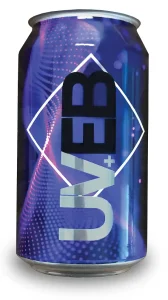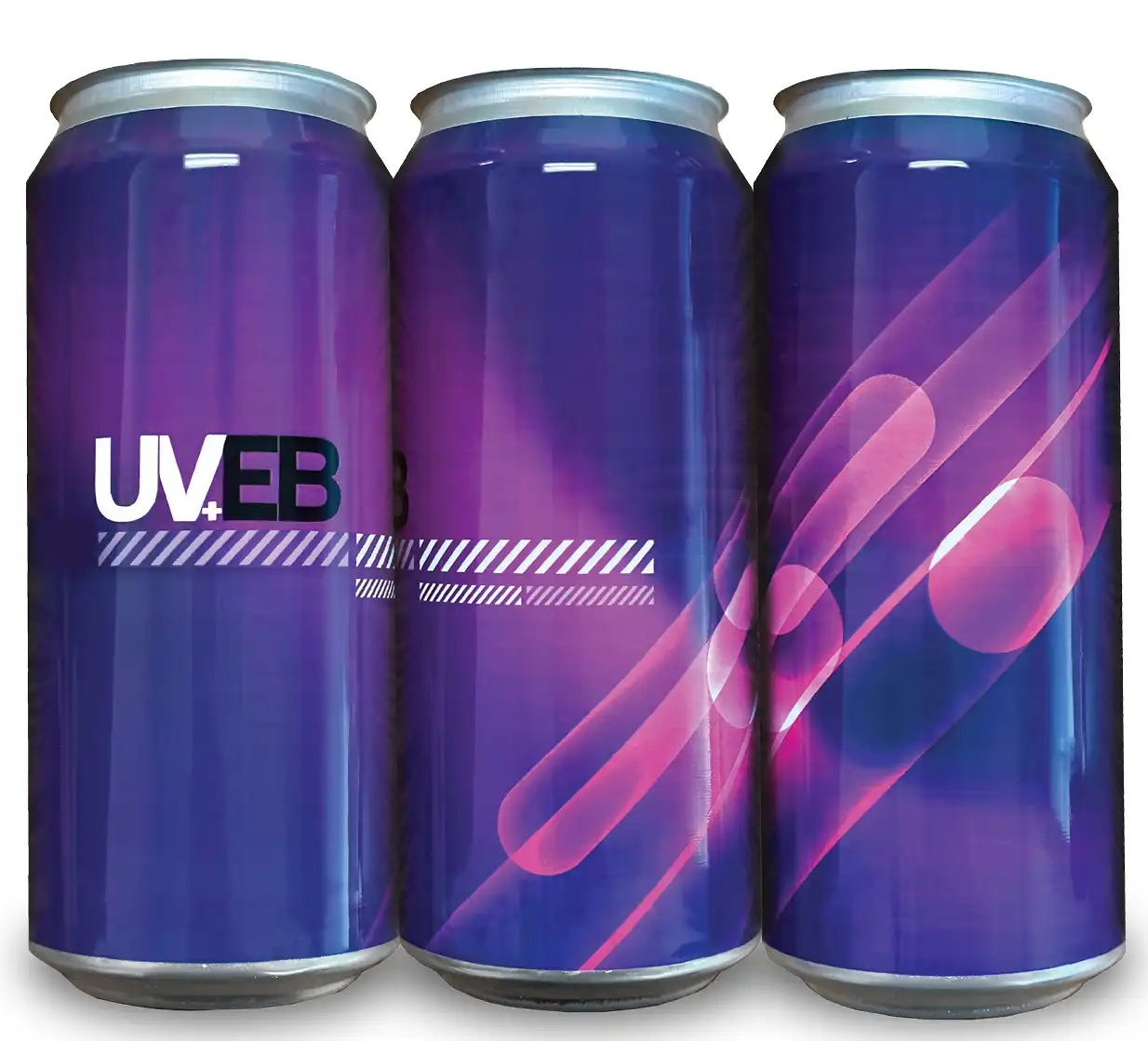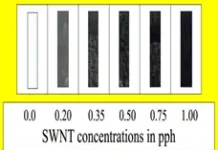By Liz Stevens, writer, UV+EB Technology
Juno DTS, West Chester Township, Ohio, is a new commercial direct-to-shape printer that chose craft beer cans as its first market sector and then geared up with the equipment, technology, inks and varnishes to print on empty cans ranging from 7.5 oz to 32 oz. The pallet-to-pallet service features an online presence for custom artwork submittal and order processing; customers supply the artwork and Juno DTS supplies the rest, shipping finished empty cans that sport exceptionally high print resolution.
 Nick DiBlasi, CEO and co-founder, described the company’s makeup and philosophy. “I have five co-founders, and each of us has an engineering background,” said DiBlasi. “I call us a team of super nerds because we like to get together and solve problems. We have experience in consumer-packaged goods in all kinds of different spaces.” The team decided to turn their talents to digital printing on three-dimensional objects, with that endeavor’s requirement to plan, coordinate and control a process with a huge volume of operations per second viewed as an enticing feature rather than a drawback. “In this kind of operation,” said DiBlasi, “there is real-time feedback and sensor fusion, and a remarkable need for high-speed throughput and split-second repetition. We are dealing with 100% parallel processing, in real time, because we are doing millions of discrete activities per second to make the entire production line and the printing module do what they are supposed
Nick DiBlasi, CEO and co-founder, described the company’s makeup and philosophy. “I have five co-founders, and each of us has an engineering background,” said DiBlasi. “I call us a team of super nerds because we like to get together and solve problems. We have experience in consumer-packaged goods in all kinds of different spaces.” The team decided to turn their talents to digital printing on three-dimensional objects, with that endeavor’s requirement to plan, coordinate and control a process with a huge volume of operations per second viewed as an enticing feature rather than a drawback. “In this kind of operation,” said DiBlasi, “there is real-time feedback and sensor fusion, and a remarkable need for high-speed throughput and split-second repetition. We are dealing with 100% parallel processing, in real time, because we are doing millions of discrete activities per second to make the entire production line and the printing module do what they are supposed
to do.”
When the group decided to tackle three-dimensional printing, they knew that some ready-made answers existed to be tapped; depalletizers, for instance, for automatically taking cans off the pallet at rates above 700 cans per minute. But the group also relished the idea of figuring out other aspects of printing on non-flat surfaces in the direct-to-shape realm.
When opportunity knocks
Juno DTS chose the craft beer can printing arena after finding that craft brewing was an underserved market as far as printed aluminum cans go. In the really big canned beverage leagues – whether it be soft drink or beer mega-producers – cans are printed in the raw aluminum state, before coatings or varnishes are applied. The can manufacturers print and varnish on a massive scale using analog technology that has been developed over the past 100 years. To acquire a printed can today, it must be sourced from a can manufacturer directly, with huge minimum order sizes – typically about 200,000 per run and up to one million cans at the height of the pandemic.
The only option for small craft breweries was to buy already-varnished cans (with different varnishes inside and out, on the necks and on the bottom rims) and apply shrink sleeves or labels to them. This, however, generates release liner waste and produces a can with either a label and adhesive or with a sleeve, both of which complicate recycling. Producing an embellished can with no label or shrink sleeve aligned with the company’s aim to promote sustainability. “Sustainability is a core principle,” said DiBlasi, “and a bit of a guiding light to our decision-making process. The Aluminum Association specifically recommends that shrink sleeves and labels should be removable to facilitate the recycling process but, unfortunately, very few of them actually are removed prior to being placed in the recycling bin. Our technology completely eliminates the material waste to create the labels and sleeves and the nuisance of removing them before recycling.”
With this state of play in mind, Juno DTS was ready to focus its technological expertise on creating an efficient, effective production line to print high-quality graphics on aluminum cans in small- to mid-sized batches. “In 2020, we did a seed funding round to go after printing on a cylindrical object,” DiBlasi explained. “We dove right in and within six months, we had a nearly fully operational prototype unit that made some spectacular images.”
The group’s production line plans were very ambitious, and included a unique bulk de-palletizer, a multi-module initial conveyor system, a vacuum decline belt, several other conveyor modules, end-of-arm-tooling devices, a proprietary can cleaning technology, the print module and UV LED curing lamps. After printing comes more conveyors, end effectors and robotics, still more conveyors, a varnish coater and a HeatTek oven for curing the varnish, a final cleaning process, and a re-palletizer at the end of the production line. For its equipment, Juno DTS designs its own circuit boards, hardware and software, only relying upon OEMs for selected technologies.
At the heart and in the middle of the production line are the company’s printing and ink curing equipment, capable of digitally printing aluminum cans at 400 per minute. This technology is proprietary to the company, but DiBlasi did share that the company uses Xaar ink jet print heads with a stated rating of 360 dots per inch; DiBlasi, however, asserts that much finer print resolution can be produced. Juno DTS uses UV LEDs at 395 nm. “That seems to be the highest yield in the LED world,” said DiBlasi, “so our chemistry matches that wavelength. We are using LED pin cure lights and also using LED full cure because it is such a better environmental choice than previous mercury technology.” DiBlasi is very happy with the Phoseon FireJet™ ONE full cure lights. “They put out a huge peak irradiance, which allows us to have a dose and increase throughput,” he said. “When we calculate our dose, the challenge is ensuring that we hit it as we optimize the rate by lowering exposure time. The thing that I particularly like about LED is it instantaneously emits its wavelength and does it consistently. Over time, it doesn’t taper off very much, so you can really count on that process doing what it is supposed to do when it is supposed to do it.” DiBlasi also talked up Phoseon’s air-cooled unit which simplifies equipment and maintenance over a water-cooled unit.
Like any technological startup, Juno DTS has faced seemingly insurmountable challenges during the course of production line conception, design, construction and fine-tuning. Challenges are, of course, only insurmountable until one digs in, does the hard work of discovery and then applies new knowledge to solve the conundrum – aided by the countless iterations of test/fail/revamp until success is finally achieved. DiBlasi described two episodes of tackling sticky problems – first with ink formulation, and then with re-printing over finished cans – that illustrate the zigzag path from discovery of a problem to implementation of a resolution.
The ink fell right off
Early on, the group at Juno DTS thought they had nailed their objective to create an efficient prototype that would print high-quality images onto beverage cans at a fast clip. “The Kansas City Royals won the World Series in 2015, and Alcides Escobar had a bizarre in-the-park homerun that years later became a rally cry for us because of his hustle,” DiBlasi recounted. “We made a beverage can with an image of the Royals players doing high-fives at home plate when Escobar scored. We were so jazzed about producing near-magazine quality art right on three-dimensional cylindrical objects.” Juno DTS had developed the concept, built the equipment and finely calibrated the printing process, all of which were endeavors that they had never attempted before. While the prototype performed as imagined, the company’s inexperience with printing on varnished aluminum cans came back to bite them.
“I was thrilled to see what we had accomplished,” DiBlasi said. “Then I grabbed a freshly printed can with its beautiful image and squeezed it, and the ink fell right off. Right in my hand! Our reaction was, ‘Oh, my goodness, what exactly is happening here?!?’” The problem, however, didn’t arise from what was happening. It arose, rather, from what was not happening; namely, adhesion. And with that, Juno DTS found itself facing a new challenge – making the ink stick to the cans.
The group turned to varnish suppliers in the aluminum beverage can sector for insight into varnish chemistry. They learned that the insides of cans are coated with a chemistry to protect the liquid, that the bottom rims of cans are coated with another chemistry to minimize sticking to conveyor systems, and that the cans’ exteriors feature a completely different varnish. The varnish suppliers could not offer Juno DTS a solution to the adhesion problem, but they did provide a bit of invaluable information. “I talked to a Ph.D. chemist from one of the varnish companies,” said DiBlasi, “and he flat out said, ‘Nick, this coating that you are looking at is our Cadillac coating, and it is quite literally designed so that nothing sticks to it. I’m pretty sure you are never going to make this work.’”
Saying “You are never going to make this work” to an engineer is the equivalent of throwing down the gauntlet. And the response from Juno DTS was, “Oh, yeah? Challenge accepted!”
DiBlasi and his colleagues thought that the beverage giants must have some method for making ink stick to varnish, but they quickly learned otherwise. The giants, it turns out, buy aluminum cans in astronomical quantities. They print onto raw aluminum when the can is formed on a mandrel, then they apply varnish and they put the neck on the can last. That news spurred the group to contact their sources for cans. “We went to the suppliers,” DiBlasi explained, “and said, ‘Hey, don’t put this stuff on. Just send us the raw cans and we’ll put the varnish on after printing to make the cans ready for the end users.’ And they said, ‘Our machines won’t run without adding the varnish. We can’t put the neck on the can without varnish because it actually lubricates the can’s necking process.’” At this point, said DiBlasi, the guys were stuck with no option except to forge ahead on their own in search of a solution. “So, we went after it,” DiBlasi said, “over and over and over again.”
“It was a time in the startup of the company,” DiBlasi explained, “when we were working nights and weekends with experimental designs that we had to try over and over again. We are working with multiple ink manufacturers, using multiple ink types and just failing repeatedly. I can’t even say how many times it didn’t work.” The ink adhesion experiments failed so many times that the group was on the verge of abandoning aluminum for a different substrate. “And then I made one of the biggest mistakes of my life,” said DiBlasi, “which happened to be a wonderfully happy accident.”
DiBlasi and co-founder Nicholas Fields were running an experiment one night, adjusting 40 independent variables, one at a time, to understand the adhesion secret. “It was 2:00 a.m., and we were exhausted,” he recalled. “We were using a little device with an analog dial in the experiments. Part of my task in the entire process was to change this dial to different settings all night long. I had done that diligently, only to find out at the very end of the night that the device was not plugged in.”
That may have been the end of the story, with a night’s worth of experimenting and samples tossed out, but Fields made a suggestion that turned out to be crucial for the team’s success. He convinced DiBlasi to keep the samples and test them for performance anyway.
“And, lo and behold,” said DiBlasi, “we had found something that worked better than anything we had tried before.” In contrast to their best ink adherence results so far – a 5% success rate – within this batch of experimentation the group found a 20% success rate. “The failure rate still was really high,” DiBlasi said, “Eighty percent of the time, the stuff fell off, but 20% of the time it actually worked. It may not sound great but that was a really dramatic improvement. And, at that point, we began to understand things.” Juno DTS was at a stage in original research where there was no book to read to find an answer, and no one with whom to consult for expert suggestions. DiBlasi’s recap of the situation is one that is familiar to many an engineer. “We worked and worked, and we got lucky one night, and then we utilized that luck to actually understand what we were doing.” The group solved the adhesion problem and went on to formulate ink that also can withstand cold temperatures and wet environments.
160,000 empty printed cans
“When we go to visit our customers, we often walk through their warehouses and see cans for beverages that are not on the market – pallet after pallet of the same can,” said DiBlasi. On one visit to a brewer, DiBlasi saw 20 pallets of cans for a beer he had never even seen before. The brewer explained that the company bought an entire semi load of printed cans – 24 pallets – but the brew just didn’t sell, and the brewer was stuck with a mountain of unusable cans. “We have nearly 160,000 cans,” the brewer told DiBlasi, “do you want them?” DiBlasi said that thoughts of color theory, base foundations, application and adhesion briefly flitted through his mind before he declined the offer and turned his attention back to other challenges at hand.
However, an idea was born. “We saw instances of this more and more,” said DiBlasi, “and the amount of waste reminded us of our desire to be sustainable and as friendly to the environment as possible. These cans are perfectly fine, they just don’t have the right thing on the outside. The amount of spoilage is staggering.” In some cases, a misspelling in the text for a can goes undetected, and a batch of unusable cans then are printed. Other times, a new brew fails to capture the market or a once-popular brew falls out of favor, and thousands of printed cans now are unneeded. And that is when a new challenge – the reprint, revarnish and recure challenge – was sparked at Juno DTS.
DiBlasi and his group now are, hopefully, closer to the end stage of the challenge than the beginning to successfully reprint, revarnish and recure batches of cans in their production line setup.
“We initially tried and, just like with ink formulation, we had an epic failure,” DiBlasi said. “We could not produce the expected pop in the printed images because the image beneath showed through.” The group tried one remedy after another, to no avail. “But that’s the nature of it,” said DiBlasi. “At Juno DTS, any time we really want to dive into innovation, we dive in with a ‘fail fast, fail early’ mentality. We try a few ideas, understand what we are dealing with and pinpoint what we are going after, and then find the way forward.”
DiBlasi says that the group now thoroughly understands the requirements and the process needed and is exploring the commercial viability of offering reprint services. “Logistically speaking,” said DiBlasi, “this would require figuring out how to get unused cans to our facility and into our production environment. That is a new level of challenge that departs from our current, very streamlined setup. Perhaps in the future we even can work directly with can producers and repurpose their setup scrap. We see opportunities like that as ways to squeeze every drop out of the sustainability lemon – in what already is a true recycling loop for aluminum packaging.”
Someone likely will tell DiBlasi that there is no way he could ever make that work, and the gauntlet will have been thrown once again. It may be that a collaboration will help Juno DTS tackle that new challenge, and DiBlasi has the mindset of a collaborator. “Juno looks for partnerships over one-time sales,” he said. “Real step change requires thought leaders, diligence and creativity. It makes the hairs stand up on my arms when I realize we are talking with the right partners. The usual equation of 1+1=2 gets all messed up and we realize that, with this partner, it might be that 1+1=10!”
For more information, visit www.junodts.com.







